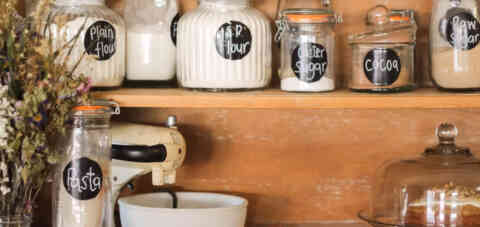Psocids

Psocids (or flour weevils) are tiny brown or black insects which live in dry foods, including flour and sugar.
Why have I got psocids?
They are NOT caused by poor hygiene – psocids can be found in the cleanest of cupboards and cleanest of kitchens. They prefer to live in dark, warm, humid places – such as the folds of packaging in food cupboards. They are attracted to damp plaster so can be found in brand new homes too. They dislike light or disturbance.
They live for about 6 months during which time the female may lay up to 100 eggs. They don't spread disease, bite or damage property. Psocid numbers can rapidly increase in number in summer and early autumn when conditions are warmer.
Psocids feed on a wide variety of food products – including flour – and also the microscopic moulds that develop in humid conditions.
Where do psocids come from?
Several independent studies have shown that the psocids found in domestic settings do not originate from food manufacturers, processors or retailers, so they are unlikely to be brought home in sealed, packaged foods.
Preventing psocids
Psocids are particularly attracted to fresh flour, so much so that if a new bag of flour is placed in the cupboard they will travel from an older bag to it, sometimes within a matter of hours. People therefore wrongly assume that the psocids came in the flour.
Domestic kitchens provide the ideal conditions for psocids: fitted cupboards provide the darkness which attracts them and flour provides food and the perfect living habitat for them.
How can I prevent psocids?
- Packets of food that have been opened should be used up quickly and not pushed out of sight to the back of the cupboard. They could also be stored in air-tight containers.
- If you are cooking, boiling the kettle or even just using the washing machine for extended periods of time, make sure the kitchen is properly ventilated.
- Many fitted kitchen cupboards are made from laminated chipboard and the surfaces that are not on view tend to have unfinished edges.
- These non-laminated sides can provide crevices for the psocids to hide in.
- They should therefore be sealed with a coat of paint or varnish.
- Regularly clear out and vacuum your cupboards, disposing of the bag in an outside bin immediately. Never use a damp cloth as this may seal dry food into crevices.
If psocids appear, you should:
- Check other foods in the cupboard.
- Remove and dispose of infested food in an outside bin and thoroughly clean cupboards, particularly crevices, using a vacuum cleaner, dispose of the vacuum bag in an outside bin immediately after use. Do not use liquid products or get the cupboards wet in any way eg no spray cleaners, cream cleaners, bleach or water.
If the problem persists, you should contact the Environmental Health Department of your local council.
For more information visit:
http://fabflour.co.uk/fab-flour/how-to-store-flour/
https://bpca.org.uk/
